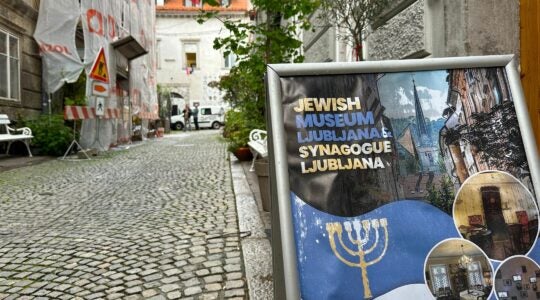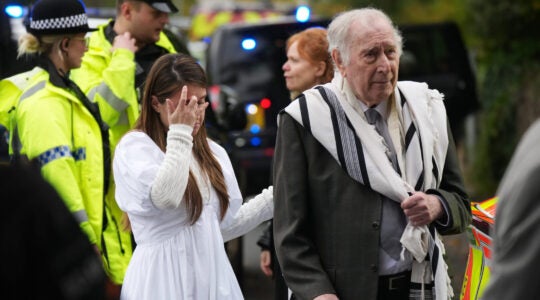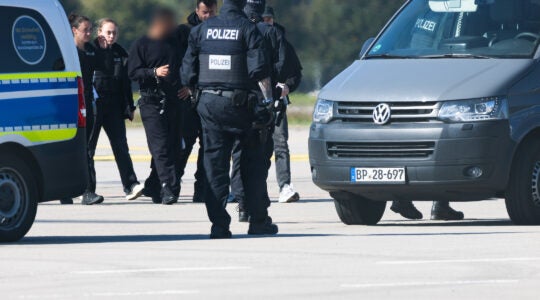Actually, they’re not. But they are important, indeed crucial, to understanding the Jewish community of Antwerp.
A generation ago, diamond jobs were plentiful and most of them stayed among Antwerp’s close-knit Jewish community. It took two or three months to train as a diamond cleaver, and when it was over you could get as much or as little work as you wanted. If you chose the latter option, you could still earn more than the average Belgian and earn enough to support a large family.
Those days are done. In a few days, I’ll have a story about just what the loss of those easy jobs have done to the community here, which is among the most unusual I have ever visited, the most obvious difference being the incredibly high percentage of religious Jews, both Orthodox and Hasidic — or, in the local parlance used to describe both, hareidisch.
You see them everywhere here, and especially along the Schupstraat, the pedestrian thoroughfare that is the heart of the diamond district. They yap in Hebrew and English, steal smokes in the entryways of the various diamond centers, and lunch on kosher food at Hoffy’s and Al Ha’aish. The roads leading into the city from the main train station are lined with jewlery shops, and a mezuzah is affixed to the door of nearly every one.
That kind of insularity breeds the deep sort of trust necessary to trade in precious gems. Which is why, if one believes Leonardo Notarbartolo, what happened on the night of February 15, 2003 would represent such a shocking breach, perhaps too shocking to believe.
Notarbartolo was the man behind most most brazen jewel heist in history, one that would make the cast of "Ocean’s 11" weep with envy. The story is laid out in suspenseful detail in the March issue of Wired. It’s worth the time, trust me. But here’s a little something to whet the appetitie.
So he strolled into the Diamond District with a pen poking out of his breast pocket. At a glance, it looked like a simple highlighter, but the cap contained a miniaturized digital camera capable of storing 100 high-resolution images. Photography is strictly limited in the district, but nobody noticed Notarbartolo’s pencam.
He began his reconnaissance at the police surveillance booth on the Schupstraat, a street leading into the center of the district. Behind the booth’s bulletproof glass, two officers monitored the area. The three main blocks of the district bristled with video cameras: Every inch of street and sky appeared to be under watch. The booth also contained the controls for the retractable steel cylinders that are deployed to prevent vehicular access to the district. As Notarbartolo walked past, he began taking pictures.
He headed toward the Diamond Center itself, a gray, 14-story, fortresslike building on the south end of the district. It had a private security force that operated a nerve center located at the entrance. Access was blocked by metal turnstiles, and visitors were questioned by guards. Notarbartolo flashed his tenant ID card and breezed through. His camera captured crisp images of everything.
He took the elevator, descending two floors underground to a small, claustrophobic room—the vault antechamber. A 3-ton steel vault door dominated the far wall. It alone had six layers of security. There was a combination wheel with numbers from 0 to 99. To enter, four numbers had to be dialed, and the digits could be seen only through a small lens on the top of the wheel. There were 100 million possible combinations.
Power tools wouldn’t do the trick. The door was rated to withstand 12 hours of nonstop drilling. Of course, the first vibrations of a drill bit would set off the embedded seismic alarm anyway.
The door was monitored by a pair of abutting metal plates, one on the door itself and one on the wall just to the right. When armed, the plates formed a magnetic field. If the door were opened, the field would break, triggering an alarm. To disarm the field, a code had to be typed into a nearby keypad. Finally, the lock required an almost-impossible-to-duplicate foot-long key.
During business hours, the door was actually left open, leaving only a steel grate to prevent access. But Notarbartolo had no intention of muscling his way in when people were around and then shooting his way out. Any break-in would have to be done at night, after the guards had locked down the vault, emptied the building, and shuttered the entrances with steel roll-gates. During those quiet midnight hours, nobody patrolled the interior—the guards trusted their technological defenses.
Notarbartolo pressed a buzzer on the steel grate. A guard upstairs glanced at the videofeed, recognized Notarbartolo, and remotely unlocked the steel grate. Notarbartolo stepped inside the vault.
It was silent—he was surrounded by thick concrete walls. The place was outfitted with motion, heat, and light detectors. A security camera transmitted his movements to the guard station, and the feed was recorded on videotape. The safe-deposit boxes themselves were made of steel and copper and required a key and combination to open. Each box had 17,576 possible combinations.
Notarbartolo went through the motions of opening and closing his box and then walked out. The vault was one of the hardest targets he’d ever seen.
JTA has documented Jewish history in real-time for over a century. Keep our journalism strong by joining us in supporting independent, award-winning reporting.





